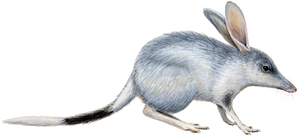Large rabbit nasal bag
| Large rabbit nasal bag | ||||||||||||
|---|---|---|---|---|---|---|---|---|---|---|---|---|

Large rabbit nasal sac ( Macrotis lagotis ) |
||||||||||||
| Systematics | ||||||||||||
|
||||||||||||
| Scientific name | ||||||||||||
| Macrotis lagotis | ||||||||||||
| Reid , 1837 |
The large rabbit nasal cone ( Macrotis lagotis ) is a species of marsupial from the group of nasal cones that lives in Australia . Its closest relative, the Little Rabbit-nosed Bunny , died out in the 20th century.
features
Large rabbit nasal cones, like all nasal cones, are stocky animals with an elongated snout. They reach a head body length of 29 to 55 centimeters, in addition there is the 20 to 29 centimeter long tail. Their weight is 0.6 to 2.5 kilograms, with the males becoming significantly heavier than the females. Their fur is long and silky, the top is blue-gray to light gray in color, the underside is white. The front half of the tail is colored black and the back half is white, there is also a small tassel. The head is characterized by the pointed, hairless muzzle and the long, finely hairy ears. The strong front legs have three claws suitable for digging, the rear legs are extended like a kangaroo and are used for jumping locomotion.
distribution and habitat
In the past, the Great Rabbit-nosed Bursers were common to over 70% of mainland Australia and inhabited forests, savannas, scrublands and deserts. Today they are restricted to a few arid areas in interior Australia. They occur naturally in the Tanami Desert in the Northern Territory , in the Gibson Desert and the Great Sand Desert in Western Australia, and in an isolated population in southwest Queensland .
Lifestyle and diet
The animals are nocturnal; during the day they withdraw into earthworks. The earthworks that the animals dig themselves have an opening and extend spirally up to two meters into the depth. When sleeping, the animals do not lie down, but sit on their back legs, put their snouts between their front legs and cover their eyes with their long ears. At night they go in search of food, moving with a hopping gait.
They live mainly solitary, in a burrow there is usually only one animal to be found, but an animal can have up to twelve burrows in its territory. Sometimes you can find the animals together in pairs.
They are omnivores that dig their food out of the earth with their strong front legs. They mainly eat insects and their larvae as well as small vertebrates, sometimes also subterranean parts of plants. They get their fluid needs from food and do not need to drink.
Reproduction
The female has a pouch open to the rear with eight teats in it. Reproduction can take place all year round, but earlier, when the animals still lived in the temperate zones of Australia, there was a fixed mating season from March to May. After a gestation period of around 14 days, the female gives birth to one or two young. As with all marsupials, these are small and underdeveloped; they spend their first 80 days in their mother's pouch. They then stay in their burrow for another two weeks and are then weaned. Sexual maturity occurs in females between 180 and 220 days and in males between 270 and 420 days. The maximum age of an animal in human care was seven years.
threat
Until the beginning of the 20th century, large rabbit-nosed whispers were widespread across much of Australia, when populations began to decline dramatically. The reasons for this lay in the hunting for their silky fur, in the stalking by introduced red foxes and house cats , in the displacement by the also introduced wild rabbits and in the destruction of their habitat by converting them into pastures or other agricultural areas. Today they have been pushed back into remote, sparsely populated regions that are not inhabited by foxes. The IUCN estimates the total population at less than 10,000 adult animals and lists the species as "endangered" ( vulnerable ).
Large rabbit nosebags are protected in Australia. There are some breeding and resettlement programs underway, with attempts to reintroduce these animals to several national parks and other protected areas in Queensland , New South Wales , South Australia and Western Australia . A nationwide protection program was set up as the basis for the protection efforts.
Since the 1970s there have been efforts to offer rabbit nosebags made of chocolate ("Easter Bilbies") as a local alternative to the Easter bunny . The income from these chocolate rabbit nasal bags is partly used for measures to protect the species.
literature
- Ronald M. Nowak: Walker's Mammals of the World . Johns Hopkins University Press, 1999, ISBN 0-8018-5789-9
Individual evidence
- ↑ a b Macrotis lagotis in the IUCN Red List of Threatened Species . Retrieved March 24, 2009.
- ^ C. Pavey: National Recovery Plan for the Greater Bilby Macrotis lagotis . Northern Territory: Australian Government, Department of Natural Resources, Environment, and the Arts. 2006 ( PDF, 407K ).
- ↑ The Australian Bilby Appreciation Society, with pictures of chocolate rabbit nasal bags
Web links
- Photos, videos and information at arkive.org
